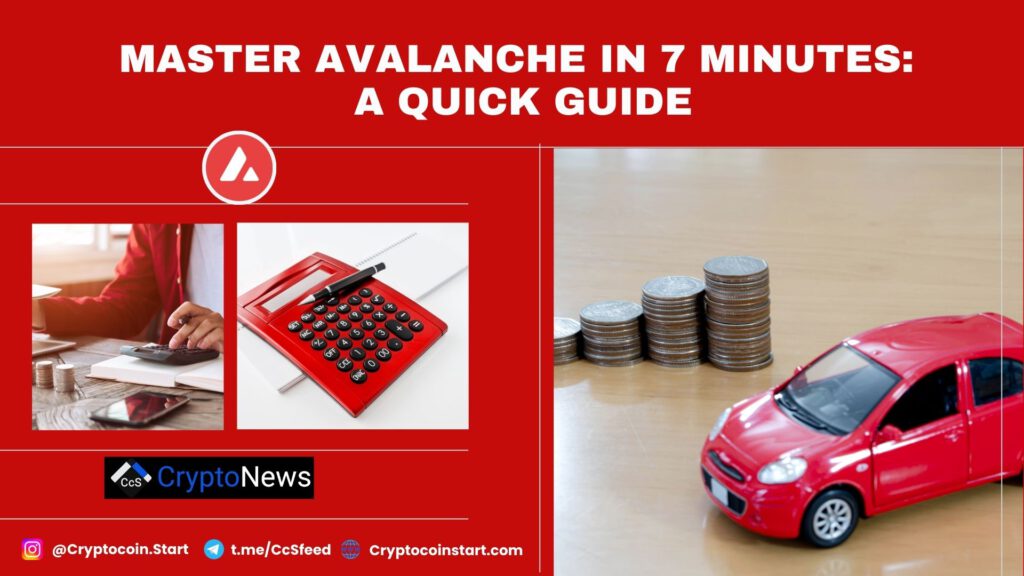
What is Avalanche?
Avalanche is a blockchain platform that’s designed for speed, low transaction fees, and scalability. Think of it as Ethereum’s faster, younger cousin. It allows developers to create decentralized applications (DApps) and even launch their own blockchains (subnets) while keeping everything running smoothly.
It was built to solve some of the biggest problems in crypto: slow transaction speeds, high fees, and network congestion. Ethereum, for example, sometimes struggles with high fees and slow transactions during peak times. Avalanche aims to fix that by offering near-instant finality and extremely low costs.
At its core, Avalanche has its own cryptocurrency called AVAX. It’s used for staking, paying fees, and securing the network. But the real magic of Avalanche lies in its unique structure. Unlike traditional blockchains, Avalanche operates on three different blockchains, each with a specific purpose. We’ll get into how that works in a bit.
History of Avalanche
Avalanche was created by Ava Labs, a company founded by Emin Gün Sirer, a Cornell University professor and blockchain expert. The project started in 2018, and by 2020, it officially launched.
Key Milestones in Avalanche’s History
- 2018 – The Avalanche consensus mechanism was first introduced by a team of researchers.
- 2019 – Ava Labs raised funding and began working on the network.
- 2020 – Avalanche launched its mainnet, making it publicly available.
- 2021 – Avalanche gained massive traction, with AVAX’s price skyrocketing and partnerships forming.
Since its launch, Avalanche has become one of the top blockchains, attracting developers, institutions, and crypto enthusiasts.
How Does Avalanche Work?
Unlike traditional blockchains, Avalanche doesn’t rely on a single chain. Instead, it uses three different chains to improve efficiency:
Three Chains of Avalanche
- X-Chain (Exchange Chain) – This handles asset creation and transfers, similar to how Bitcoin is used for transactions.
- C-Chain (Contract Chain) – This is where smart contracts are executed, making it compatible with Ethereum’s DApps.
- P-Chain (Platform Chain) – This manages validators and helps create custom subnets (individual blockchains).
By splitting tasks between these chains, Avalanche avoids congestion, making transactions super fast and cheap. For example, Ethereum processes around 15 transactions per second (TPS), while Avalanche can handle over 4,500 TPS. That’s a game-changer for scalability.
Advantages of Avalanche
Avalanche has some major advantages that make it stand out in the crypto world:
- Speed – Transactions settle in less than two seconds. No more waiting for minutes or even hours.
- Low Fees – Compared to Ethereum’s sometimes ridiculous gas fees, Avalanche keeps costs low.
- Scalability – The network doesn’t slow down even when usage increases.
- Ethereum Compatibility – Developers can easily move their projects from Ethereum to Avalanche.
- Security – Avalanche’s unique consensus mechanism makes it more resistant to attacks.
- Eco-Friendly – Unlike Bitcoin, which uses proof-of-work (PoW), Avalanche uses proof-of-stake (PoS), which is much more energy-efficient.
Disadvantages of Avalanche
Like any technology, Avalanche also faces some challenges:
- Competition – Ethereum, Solana, and others are also working on scalability solutions.
- Centralization Concerns – Some critics argue that a small number of validators control most of the AVAX supply.
- Adoption – While growing, Avalanche still needs more developers and projects to truly compete with Ethereum.
Is Avalanche a Good Investment?
This is the big question: should you invest in AVAX?
Like any cryptocurrency, AVAX has had its ups and downs. It saw huge gains in 2021, reaching an all-time high of around $146. However, it also faced major corrections.
Why Some Investors Are Bullish on AVAX
- Strong Technology – Avalanche’s speed and low fees make it attractive for DApps.
- Growing Ecosystem – More projects are launching on Avalanche, expanding its utility.
- Institutional Interest – Big players are starting to take notice of Avalanche.
Risks of Investing in AVAX
- Crypto Volatility – Prices can swing wildly in the cryptocurrency market.
- Regulatory Uncertainty – Governments may impose regulations that could affect the market.
- Competition – Ethereum and other blockchains are not standing still, making Avalanche’s future uncertain.
If you believe in Avalanche’s long-term potential, it could be a solid investment. However, always do your research and never invest more than you can afford to lose.
The Future of Avalanche
Avalanche has a bright future, but it won’t be an easy ride. Here’s what could happen next:
- More Adoption – If more developers and institutions join, Avalanche could challenge Ethereum.
- Better Upgrades – Avalanche continues to improve its scalability and security features.
- Stronger Partnerships – More collaborations could help expand its ecosystem.
- Price Growth? – If demand for the platform increases, AVAX could see price appreciation.
Final Thoughts
Avalanche is like the high-speed train of the crypto world. It’s fast, efficient, and designed to handle huge amounts of traffic without slowing down. While it may not replace Ethereum, Avalanche is poised to play a major role in the future of blockchain technology.
So, whether you’re an investor, developer, or just curious about crypto, Avalanche is one name you should definitely keep an eye on.

